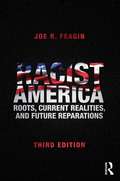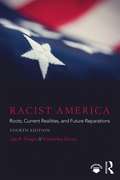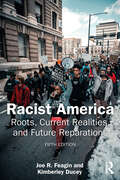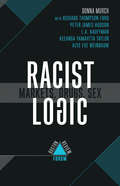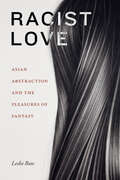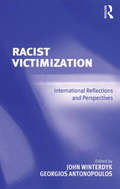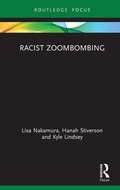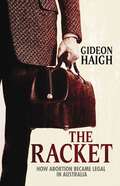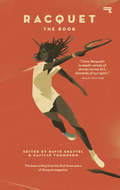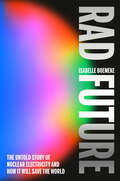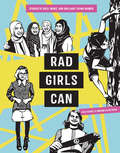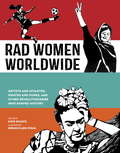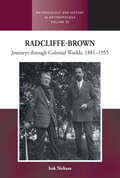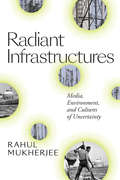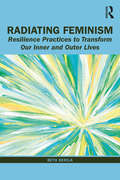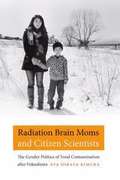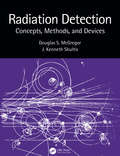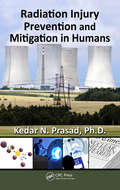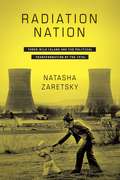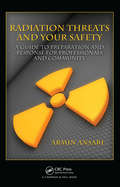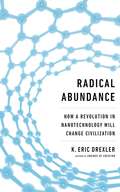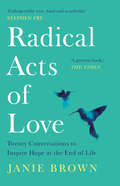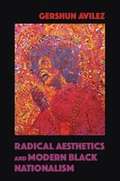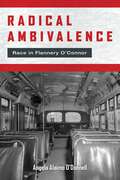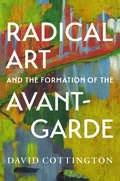- Table View
- List View
Racist America: Roots, Current Realities, and Future Reparations
by Joe R. FeaginThis third edition of Joe R. Feagin's Racist America is significantly revised and updated, with an eye toward racism issues arising regularly in our contemporary era. This edition incorporates more than two hundred recent research studies and reports on U.S. racial issues that update and enhance all the last edition's chapters. It expands the discussion and data on concepts such as the white racial frame and systemic racism from research studies by Feagin and his colleagues. The author has further polished the book to make it yet more readable for undergraduates, including eliminating repetitive materials, adding headings and more cross-referencing, and adding new examples, anecdotes, and narratives about contemporary racism.
Racist America: Roots, Current Realities, and Future Reparations
by Joe R. Feagin Kimberley DuceyThis fourth edition of Racist America is significantly revised and updated, with an eye toward racism issues arising regularly in our contemporary era. This edition incorporates many recent research studies and reports on U.S. racial issues that update and enhance the last edition’s chapters. It expands the discussion and data on social science concepts such as intersectionality and gendered racism, as well as the concepts of the white racial frame, systemic racism, and the elite-white-male dominance system from research studies by Joe Feagin and his colleagues. The authors have further polished the book and added more examples, anecdotes, and narratives about contemporary racism to make it yet more readable for undergraduates. Student objectives, summaries, key terms, and study questions are available under the e-Resources tab at www.routledge.com/9781138096042.
Racist America: Roots, Current Realities, and Future Reparations
by Joe R. Feagin Kimberley DuceyThe fifth edition of Racist America is thoroughly revised and updated, focusing on systemic racism and antiracism issues, especially those arising since the fourth edition (2019). Expanding the discussion on racialized intersectionality, as well as on the white racial frame, elite-white-male dominance system, and antiracist action, this book details how these racism realities continue to impact black, Latino, Asian, Indigenous, and white Americans. The book explains how and why the Black Lives Matter movement and other antiracist protests have erupted; how and why Latino, Asian, and Indigenous Americans have responded to expanding racist discrimination; and how and why a diverse array of Americans has demanded major societal responses to dismantle entrenched white racism.
Racist Logic: Markets, Drugs, Sex (Boston Review)
by Donna MurchThe history of international banking, the commodification of black masculinity, the buying and selling of women's eggs, Michelle Obama's dubious advice to black youth, and the workings of affirmative action at elite universities viewed through the lens of racial capitalism. In Racist Logic, lead essayist Donna Murch writes that “historically, the division between 'dope' and medicine was the race and class of users.” By using the concept of “racial capitalism” to examine the opioid crisis alongside the War on Drugs, Murch brings an otherwise familiar story into new territory. To understand the twisted logic that created the divergent responses to drug use—succor and sympathy for white users, prison and expulsion for people of color—Murch shows how a racialized regime of drug prohibitions led Purdue Pharma to market OxyContin specifically to whites. Alongside Murch, contributors consider how racial capitalism helps us understand the history of international banking, the commodification of black masculinity, the buying and selling of women's eggs, Michelle Obama's dubious advice to black youth, and the workings of affirmative action at elite universities. Contributors Michael Collins, Richard Thompson Ford, Helena Hansen, David Herzberg, Peter James Hudson, Jonathan Kahn, L.A. Kauffman, Julilly Kohler-Hausmann, Jordanna Matlon, Max Mishler, Donna Murch, Julie Netherland, Britt Rusert, Keeanga-Yamahtta Taylor, Alys Eve Weinbaum
Racist Love: Asian Abstraction and the Pleasures of Fantasy (ANIMA: Critical Race Studies Otherwise)
by Leslie BowIn Racist Love Leslie Bow traces the ways in which Asian Americans become objects of anxiety and desire. Conceptualizing these feelings as “racist love,” she explores how race is abstracted and then projected onto Asianized objects. Bow shows how anthropomorphic objects and images such as cartoon animals in children’s books, home décor and cute tchotchkes, contemporary visual art, and artificially intelligent robots function as repositories of seemingly positive feelings and attachment to Asianness. At the same time, Bow demonstrates that these Asianized proxies reveal how fetishistic attraction and pleasure serve as a source of anti-Asian bias and violence. By outlining how attraction to popular representations of Asianness cloaks racial resentment and fears of globalization, Bow provides a new means of understanding the ambivalence surrounding Asians in the United States while offering a theory of the psychological, affective, and symbolic dynamics of racist love in contemporary America.
Racist Victimization: International Reflections and Perspectives
by Georgios AntonopoulosThis book investigates the phenomenon of racist victimization in a number of countries, uncovering and analyzing its historical roots, its relation to the legal system in a particular national context, its extent and the response to it. Through the international comparative approach adopted and the broad geographical range of studies presented, including national settings which have so far been largely ignored by the literature on racist victimization, the volume offers a truly international perspective on an important social, political and academic issue. As such, Racist Victimization: International Reflections and Perspectives will constitute essential reading not only for sociologists and socio-legal scholars, but for anyone working in the field of race and ethnicity, crime and justice, criminology, victimology or policing.
Racist Zoombombing
by Lisa Nakamura Hanah Stiverson Kyle LindseyThis book examines Zoombombing, the racist harassment and hate speech on Zoom. While most accounts refer to Zoombombing as simply a new style or practice of online trolling and harassment in the wake of increased videoconferencing since the outbreak of COVID-19, this volume examines it as a specifically racialized and gendered phenomenon that targets Black people and communities with racialized and gendered harassment. Racist Zoombombing brings together histories of online racism and algorithmic warfare with in-depth interviews by Black users on their experiences. The book explains how Zoombombing is a form of racial violence, interrogates our ideas about online space and community, and challenges our notions of on and off line distinction between racial harassment of Black people and communities. A vital resource for media, culture, and communication students and scholars that are interested in race, gender, digital media, and digital culture.
Racket: How Abortion Became Legal In Australia
by Gideon HaighA generation ago in Australia, abortion was a crime. It was also the basis of one of the country's most lucrative and longest-lasting criminal rackets.The Racket describes the rise and fall of an extraordinary web of influence, which culminated in the landmark ruling that made abortion legal, and a public inquiry that humiliated a powerful government and a glamorous police force. With forensic skill and psychological subtlety, Gideon Haigh brings to life a story of corruption in high places and human suffering in low, of murder, suicide, courtroom drama, political machinations, and of the abortionists themselves: among them a multi-millionaire philanthropist, a communist bush poet, a timid aesthete and a bankrupt slaughterman.It is the story, too, of Bertram Wainer, abortion's crash-through-or-crash campaigner, and the moral issue he bequeathed which still divides Australians.
Racquet Magazine: The Book
by David Shaftel and Caitlin ThompsonThe best writing on tennis from the best tennis writers in the business.Racquet was founded in 2016 to be the voice of a new tennis boom. When the popularity of tennis peaked in the late '70s and early '80s, the sport was populated by buccaneering talents with outsize personas, such as Borg, Evert, McEnroe, Navratilova, Gerulaitis, Austin, King, and Connors. The game was played in every park, and tennis clothes became appropriate attire for cocktails as well as for a match. With success, however, came polish, and tennis--if not the game itself, then how it came to be represented in the culture--got boring. Having a big personality was no longer a virtue. Tennis went back to being a bastion of the elite. Racquet is a place for those who knew all along that the spirit of the tennis boom was alive. Tennis has always been present in the arts, in the popular culture, in the skateboarding, hip-hop, and fashion worlds. That side of tennis was--and is--obscured by the tightly controlled messaging of the athletes, the corporate glean of the major tournaments, and the all-white attire of the country-club scene. Racquet was launched to represent the latent, diverse, and large constituency of tennis that has not been embraced by the sport writ large. Featuring the work of some of today's finest writers, the quarterly independent magazine highlights the art, culture, and style that are adjacent to the sport--and just enough of the pro game to keep the diehards satisfied. This collection features some of the best writing from the first four years of Racquet and tackles such immediate topics as: How should tennis smell? What's the deal with Andre Agassi's private jet? What can a professional tennis player learn from Philip Roth? Why is tennis important in Lolita? How was Arthur Ashe like Muhammad Ali? And, crucially, what lessons have we learned from the implosion of that first tennis boom?
Rad Future: The Untold Story of Nuclear Electricity and How It Will Save the World
by Isabelle BoemekeWe&’re running out of time. Fossil fuels are choking the planet and renewable energy isn&’t cutting it. The solution has been hiding in plain sight all along.Nuclear.When most people hear that word, they go to a very bad place: bombs, Chernobyl, hazmat suits, radioactive fallout… the stuff of nightmares. But what if everything you think you know about nuclear is wrong?In Rad Future, science influencer Isabelle Boemeke shatters the fear and misinformation surrounding this technology and shows how the actual science tells a different story. It turns out that nuclear-generated electricity—nuclear electricity—is our best option for ensuring the future of the planet. Nuclear can power cities, desalinate water, create carbon-free fertilizer, and heat homes, all with the smallest environmental footprint of any energy source.Boemeke exposes how decades of fearmongering, a few dramatic (but preventable) disasters, and relentless bad PR have convinced the world that nuclear is dangerous when it&’s actually the key to an affordable, sustainable future. We&’ve fumbled the bag on the cleanest, most powerful energy source we have, and it&’s time to fix that.This isn&’t your typical science book. Boemeke&’s signature mix of humor, sass, and deep research makes Rad Future a wild ride through the science, history, and future of nuclear electricity. From Cold War politics to Hollywood-fueled paranoia to cutting-edge reactor designs, she details exactly how nuclear works and why it&’s our best shot at ending the climate crisis and creating a future of radical abundance. Rad Future is the first truly accessible breakdown of nuclear electricity, and it will leave you feeling stoked about what&’s possible.
Rad Girls Can: Stories of Bold, Brave, and Brilliant Young Women (Rad Women)
by Kate Schatz Miriam Klein StahlFrom the New York Times best-selling authors of Rad Women Worldwide and Rad American Women A-Z, a bold and brave collection of stories and art about inspiring and accomplished girls who have made positive impacts on the world before the age of 20. <P><P>You might know the stories of Malala Yousafzai, Anne Frank, Jazz Jennings, and Joan of Arc. <P><P>But have you heard about Yusra Mardini, a Syrian refugee who swam a sinking boat to shore, saved twenty lives, then went on to compete as an Olympic swimmer? Or Trisha Prabhu, who invented an anti-cyberbullying app at age 13? Or Barbara Rose Johns, whose high school protest helped spark the civil rights movement? <P><P>In Rad Girls Can, you'll learn about a diverse group of young women who are living rad lives, whether excelling in male-dominated sports like boxing, rock climbing, or skateboarding; speaking out against injustice and discrimination; expressing themselves through dance, writing, and music; or advocating for girls around the world. Each profile is paired with the dynamic paper-cut art that made the authors' first two books New York Times best sellers. <P><P>Featuring both contemporary and historical figures, Rad Girls Can offers hope, inspiration, and motivation to readers of all ages and genders.
Rad Women Worldwide: Artists and Athletes, Pirates and Punks, and Other Revolutionaries Who Shaped History (Rad Women)
by Kate Schatz Miriam Klein StahlFrom the authors of the New York Times bestselling book Rad American Women A-Z, comes a bold new collection of 40 biographical profiles, each accompanied by a striking illustrated portrait, showcasing extraordinary women from around the world.Rad Women Worldwide tells fresh, engaging, and inspiring tales of perseverance and radical success by pairing well researched and riveting biographies with powerful and expressive cut-paper portraits. From 430 BCE to 2016, spanning 31 countries around the world, the book features an array of diverse figures, including Hatshepsut (the great female king who ruled Egypt peacefully for two decades) and Malala Yousafzi (the youngest person to win the Nobel Peace Prize) to Poly Styrene (legendary teenage punk and lead singer of X-Ray Spex) and Liv Arnesen and Ann Bancroft (polar explorers and the first women to cross Antarctica). This progressive and visually arresting book is a compelling addition to women's history and belongs on the shelf of every school, library, and home. Together, these stories show the immense range of what women have done and can do. May we all have the courage to be rad!From the Hardcover edition.
Radcliffe-Brown: Journeys Through Colonial Worlds, 1881-1955 (Methodology & History in Anthropology #50)
by Isak NiehausAlfred Radcliffe-Brown (1881-1955) is widely renowned as a founder of modern social anthropology. This biography challenges popular stereotypes of him as a misplaced positivist and colonial conservative. It shows Radcliffe-Brown to be a thoroughly cosmopolitan scholar, a committed fieldworker and a sharp critic of colonialism. Radcliffe-Brown engaged strategically with colonial authorities to further the interests of his discipline and invoked scientific credentials to critique central aspects of colonial rule. His struggle for intellectual autonomy and advocacy of a comparative sociological approach speaks to many contemporary concerns.
Radiant Infrastructures: Media, Environment, and Cultures of Uncertainty (Sign, Storage, Transmission)
by Rahul MukherjeeIn Radiant Infrastructures Rahul Mukherjee explores how the media coverage of nuclear power plants and cellular phone antennas in India—what he calls radiant infrastructures—creates environmental publics: groups of activists, scientists, and policy makers who use media to influence public opinion. In documentaries, lifestyle television shows, newspapers, and Bollywood films, and through other forms of media (including radiation-sensing technologies), these publics articulate contesting views about the relationships between modernity, wireless signals, and nuclear power. From testimonies of cancer patients who live close to cell towers to power plant operators working to contain information about radiation leaks and health risks, discussions in the media show how radiant infrastructures are at once harbingers of optimism about India's development and emitters of potentially carcinogenic radiation. In tracing these dynamics, Mukherjee expands understandings of the relationship between media and infrastructure and how people make sense of their everyday encounters with technology and the environment.
Radiating Feminism: Resilience Practices to Transform our Inner and Outer Lives
by Beth BerilaRadiating Feminism: Resilience Practices to Transform Our Inner and Outer Lives is a practical guide to embodying feminist principles not just in our politics, but also in our very ways of being. Bringing together intersectional feminism with mindful reflection and embodied practice, this book offers practical wisdom for living by feminist principles in our daily lives. Each chapter includes practices and interactive activities to help navigate common challenges along feminist journeys. The book also draws on wisdom from feminist leaders and contemporary conversations from social justice movements. Both inspiring and guiding, the book will provide readers with the skills to cultivate resilience to face the many barriers to feminist social transformation. Radiating Feminism will be of use to students of Gender Studies, Social Work, Psychology, Community Health, and the Social Sciences, as well as anyone with a longstanding or fresh commitment to feminism and social justice.
Radiation Brain Moms and Citizen Scientists: The Gender Politics of Food Contamination after Fukushima
by Aya Hirata KimuraFollowing the Fukushima Daiichi Nuclear Power Plant disaster in 2011 many concerned citizens--particularly mothers--were unconvinced by the Japanese government's assurances that the country's food supply was safe. They took matters into their own hands, collecting their own scientific data that revealed radiation-contaminated food. In Radiation Brain Moms and Citizen Scientists Aya Hirata Kimura shows how, instead of being praised for their concern about their communities' health and safety, they faced stiff social sanctions, which dismissed their results by attributing them to the work of irrational and rumor-spreading women who lacked scientific knowledge. These citizen scientists were unsuccessful at gaining political traction, as they were constrained by neoliberal and traditional gender ideologies that dictated how private citizens--especially women--should act. By highlighting the challenges these citizen scientists faced, Kimura provides insights into the complicated relationship between science, foodways, gender, and politics in post-Fukushima Japan and beyond.
Radiation Detection: Concepts, Methods, and Devices
by J. Kenneth Shultis Douglas McGregorRadiation Detection: Concepts, Methods, and Devices provides a modern overview of radiation detection devices and radiation measurement methods. The book topics have been selected on the basis of the authors’ many years of experience designing radiation detectors and teaching radiation detection and measurement in a classroom environment. This book is designed to give the reader more than a glimpse at radiation detection devices and a few packaged equations. Rather it seeks to provide an understanding that allows the reader to choose the appropriate detection technology for a particular application, to design detectors, and to competently perform radiation measurements. The authors describe assumptions used to derive frequently encountered equations used in radiation detection and measurement, thereby providing insight when and when not to apply the many approaches used in different aspects of radiation detection. Detailed in many of the chapters are specific aspects of radiation detectors, including comprehensive reviews of the historical development and current state of each topic. Such a review necessarily entails citations to many of the important discoveries, providing a resource to find quickly additional and more detailed information. This book generally has five main themes: Physics and Electrostatics needed to Design Radiation Detectors Properties and Design of Common Radiation Detectors Description and Modeling of the Different Types of Radiation Detectors Radiation Measurements and Subsequent Analysis Introductory Electronics Used for Radiation Detectors Topics covered include atomic and nuclear physics, radiation interactions, sources of radiation, and background radiation. Detector operation is addressed with chapters on radiation counting statistics, radiation source and detector effects, electrostatics for signal generation, solid-state and semiconductor physics, background radiations, and radiation counting and spectroscopy. Detectors for gamma-rays, charged-particles, and neutrons are detailed in chapters on gas-filled, scintillator, semiconductor, thermoluminescence and optically stimulated luminescence, photographic film, and a variety of other detection devices.
Radiation Injury Prevention and Mitigation in Humans
by Kedar PrasadWith an estimated 3.3 billion ionizing radiation imaging examinations performed worldwide each year, the growing use of x-ray-based diagnostic procedures raises concerns about long-term health risks, especially cancer. In addition, rapid growth in the number of nuclear power plants around the world increases the risk of a nuclear accident similar t
Radiation Nation: Three Mile Island and the Political Transformation of the 1970s
by Natasha ZaretskyOn March 28, 1979, the worst nuclear reactor accident in U.S. history occurred at the Three Mile Island power plant in Central Pennsylvania. Radiation Nation tells the story of what happened that day and in the months and years that followed, as local residents tried to make sense of the emergency. The near-meltdown occurred at a pivotal moment when the New Deal coalition was unraveling, trust in government was eroding, conservatives were consolidating their power, and the political left was becoming marginalized. Using the accident to explore this turning point, Natasha Zaretsky provides a fresh interpretation of the era by disclosing how atomic and ecological imaginaries shaped the conservative ascendancy.Drawing on the testimony of the men and women who lived in the shadow of the reactor, Radiation Nation shows that the region's citizens, especially its mothers, grew convinced that they had sustained radiological injuries that threatened their reproductive futures. Taking inspiration from the antiwar, environmental, and feminist movements, women at Three Mile Island crafted a homegrown ecological politics that wove together concerns over radiological threats to the body, the struggle over abortion and reproductive rights, and eroding trust in authority. This politics was shaped above all by what Zaretsky calls "biotic nationalism," a new body-centered nationalism that imagined the nation as a living, mortal being and portrayed sickened Americans as evidence of betrayal. The first cultural history of the accident, Radiation Nation reveals the surprising ecological dimensions of post-Vietnam conservatism while showing how growing anxieties surrounding bodily illness infused the political realignment of the 1970s in ways that blurred any easy distinction between left and right.
Radiation Threats and Your Safety: A Guide to Preparation and Response for Professionals and Community
by Armin AnsariWhile it has aided far many more than it has harmed, radiation is forever etched in the public's mind as an indiscriminate and particularly pernicious killer. Consequently, it is especially critical in this age of terrorist threats that we equip ourselves with accurate information and practical tools that will serve us in the rare chance that we find ourselves in a radiation crisis.Radiation Threats and Your Safety: A Guide to Preparation and Response for Professionals and Community offers a calm and authoritative approach to crisis preparation. Written by a health physicist from the U.S. Centers for Disease Control and Prevention, the book informs us about what we should know ahead of time, how to prepare, and the best ways to respond to a nuclear or radiological incident either as an emergency responder or community/family member. Organized to serve both as a preparation guide and as a reference in a crisis, this book -Uses common language while avoiding unnecessary scientific jargon -Details protocols for both accidental and intentional radiation emergencies such as nuclear explosions and dirty bombs-Shows how to prepare a family emergency plan-Covers medical responses to radiation emergencies including radiation drugs -Provides an emergency supply list -Discusses radiation from microwaves and cellular phones as well as food irradiation There is no reason why we should feel helpless when faced with a radiation emergency. We can take action to protect ourselves, our families, and our communities. How we react to a radiation emergency will determine its true final impact. To this end, we need information and leaders we can depend upon.
Radical Abundance: How a Revolution in Nanotechnology Will Change Civilization
by K. Eric DrexlerK. Eric Drexler is the founding father of nanotechnology-the science of engineering on a molecular level. In Radical Abundance, he shows how rapid scientific progress is about to change our world. Thanks to atomically precise manufacturing, we will soon have the power to produce radically more of what people want, and at a lower cost. The result will shake the very foundations of our economy and environment. Already, scientists have constructed prototypes for circuit boards built of millions of precisely arranged atoms. The advent of this kind of atomic precision promises to change the way we make things-cleanly, inexpensively, and on a global scale. It allows us to imagine a world where solar arrays cost no more than cardboard and aluminum foil, and laptops cost about the same. A provocative tour of cutting edge science and its implications by the field’s founder and master, Radical Abundance offers a mind-expanding vision of a world hurtling toward an unexpected future.
Radical Acts of Love: How we find hope at the end of life
by Janie BrownA deeply moving and ultimately uplifting exploration of our last great challenge.In this profound and moving book, oncology nurse Janie Brown recounts twenty conversations she has had with the dying, including people close to her. Each conversation uncovers a different perspective on, and experience of death, while at the same time exploring its universalities. Offering extremely sensitive and wise insight into our final moments, Brown shows practical ways to facilitate the shift from feeling helpless about death to feeling hopeful; from fear to acceptance; from feeling disconnected and alone, to becoming part of the wider, collective story of our mortality.As Janie Brown writes, "Most people now under sixty have never seen a person die, and so have become deeply fearful about death, their own and the deaths of their beloved others. They have had no role models to show them how to care for a dying person, and therefore no confidence in being able to do so. My hope is that the baby boomer cohort who pushed for the return of the midwives to de-medicalize birth will also be instrumental in reclaiming the death process. This book is my contribution to the re-empowerment of all of us to take charge of our lives and our deaths, remembering that we know how to die, just as we knew how to come into this world. We also know how to heal, and to settle our lives as best we can, before we die. In my view, this is the greatest gift we could give our loved ones: to be prepared and open and accepting when the time comes for us to leave this world."
Radical Aesthetics and Modern Black Nationalism (The New Black Studies Series)
by GerShun AvilezRadical Aesthetics and Modern Black Nationalism explores the long-overlooked links between black nationalist activism and the renaissance of artistic experimentation emerging from recent African American literature, visual art, and film. GerShun Avilez charts a new genealogy of contemporary African American artistic production that illuminates how questions of gender and sexuality guided artistic experimentation in the Black Arts Movement from the mid-1960s to the mid-1970s. As Avilez shows, the artistic production of the Black Arts era provides a set of critical methodologies and paradigms rooted in the disidentification with black nationalist discourses. Avilez's close readings study how this emerging subjectivity, termed aesthetic radicalism , critiqued nationalist rhetoric in the past. It also continues to offer novel means for expressing black intimacy and embodiment via experimental works of art and innovative artistic methods. A bold addition to an advancing field, Radical Aesthetics and Modern Black Nationalism rewrites recent black cultural production even as it uncovers unexpected ways of locating black radicalism.
Radical Ambivalence: Race in Flannery O'Connor (Studies in the Catholic Imagination: The Flannery O'Connor Trust Series)
by Angela Alaimo O'DonnellRadical Ambivalence is the first book-length study of Flannery O’Connor’s attitude toward race in her fiction and correspondence. It is also the first study to include controversial material from unpublished letters that reveals the complex and troubling nature of O’Connor’s thoughts on the subject. O’Connor lived and did most of her writing in her native Georgia during the tumultuous years of the civil rights movement. In one of her letters, O’Connor frankly expresses her double-mindedness regarding the social and political upheaval taking place in the United States with regard to race: “I hope that to be of two minds about some things is not to be neutral.” Radical Ambivalence explores this double-mindedness and how it manifests itself in O’Connor’s fiction.
Radical Art and the Formation of the Avant-Garde
by David CottingtonAn authoritative re-definition of the social, cultural and visual history of the emergence of the &“avant-garde&” in Paris and London Over the past fifty years, the term "avant-garde" has come to shape discussions of European culture and modernity, ubiquitously taken for granted but rarely defined. This ground-breaking book develops an original and searching methodology that fundamentally reconfigures the social, cultural, and visual context of the emergence of the artistic avant-garde in Paris and London before 1915, bringing the material history of its formation into clearer and more detailed focus than ever before. Drawing on a wealth of disciplinary evidence, from socio-economics to histories of sexuality, bohemia, consumerism, politics, and popular culture, David Cottington explores the different models of cultural collectivity in, and presumed hierarchies between, these two focal cities, while identifying points of ideological influence and difference between them. He reveals the avant-garde to be at once complicit with, resistant to, and a product of the modernizing forces of professionalization, challenging the conventional wisdom on this moment of cultural formation and offering the means to reset the terms of avant-garde studies.
